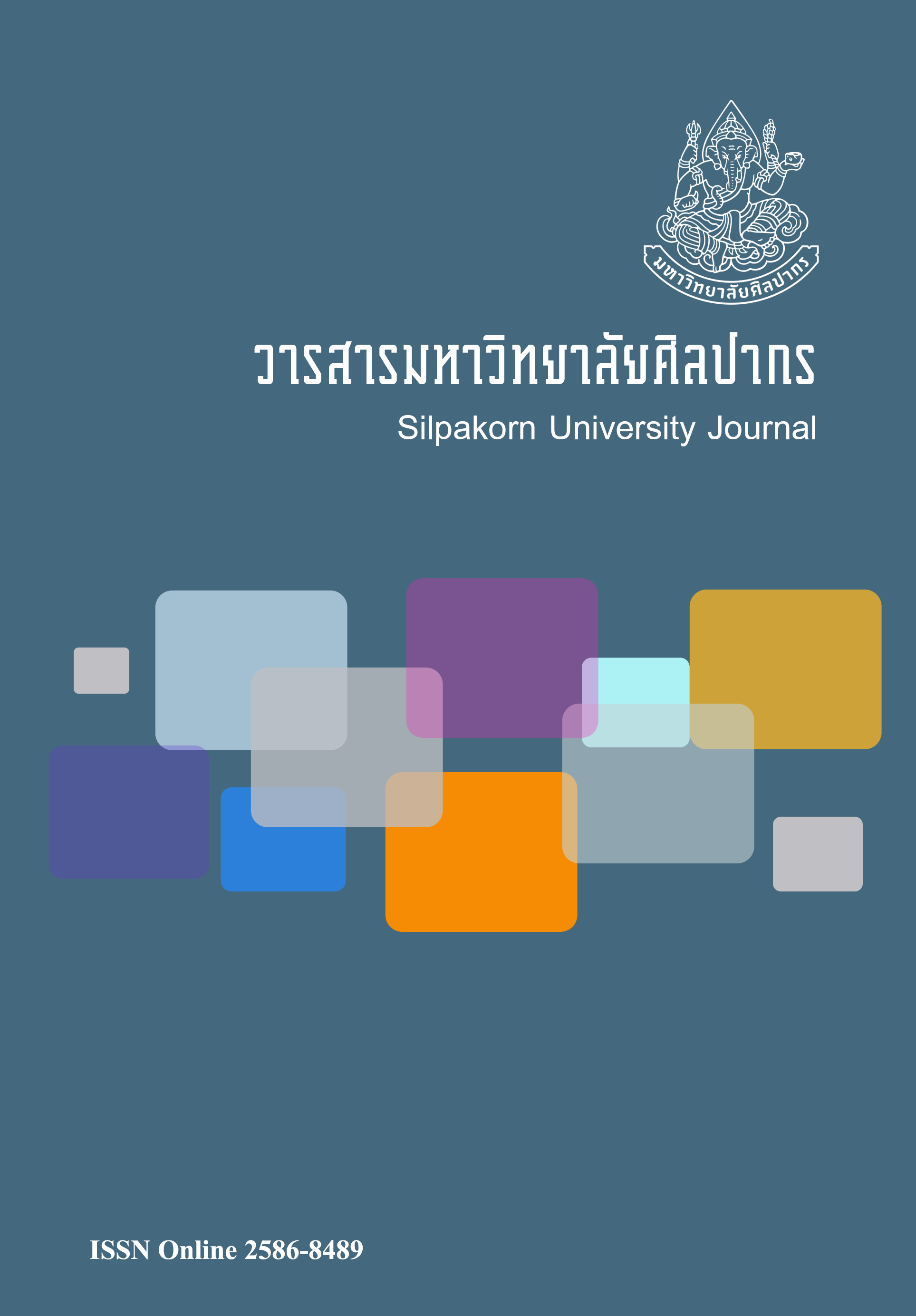การศึกษาสภาพปัญหาการปล่อยสินเชื่อเพื่อวิสาหกิจขนาดกลางและขนาดย่อม (SMEs) : สถาบันการเงินในจังหวัดพะเยา (A study of credit lending problems for Small and Medium Enterprises (SMEs): financial institutions in Phayao province)
Main Article Content
Abstract
สถาบันการเงินคือหน่วยเศรษฐกิจที่มีบทบาทสำคัญในการเป็นแหล่งระดมเงินทุนที่มีขนาดใหญ่ที่สุดสำหรับผู้ประกอบการวิสาหกิจขนาดกลางและขนาดย่อมที่มีความต้องการด้านเงินทุนเพื่อนำไปใช้ในการดำเนินธุรกิจ ทั้งนี้ในระยะหลายปีที่ผ่านมาจะสังเกตเห็นว่าการปล่อยสินเชื่อของสถาบันการเงินในประเทศไทยมีปริมาณลดลงเรื่อยๆ ซึ่งจากรายงานทางสถิติของธนาคารแห่งประเทศไทย พบว่าสถาบันการเงินในจังหวัดพะเยามีปริมาณการปล่อยสินเชื่อลดลง ดังนั้นผู้วิจัยจึงมีความสนใจศึกษาสภาพปัญหาที่เกิดขึ้น เพื่อแก้ไขปัญหาการปล่อยสินเชื่อของผู้ประกอบการวิสาหกิจขนาดกลางและขนาดย่อมในจังหวัดพะเยา ผลการวิจัยพบว่ามี 2 ตัวแปรที่สามารถนำไปใช้ในการพยากรณ์ปริมาณของสินเชื่อ ซึ่งประกอบไปด้วย ความเสี่ยงที่มีผลกระทบต่อธุรกิจ และหลักประกัน และมี 6 ตัวแปรที่มีอิทธิพลต่อการวิเคราะห์ 6 C’s ได้แก่ ความพอเพียงของเงินทุน คุณภาพของสินทรัพย์ ความสามารถในการบริหาร ความสามารถในการทำกำไร สภาพคล่อง และความเสี่ยงที่มีผลกระทบต่อธุรกิจ นอกจากนี้ผู้วิจัยยังพบปัญหาในการปล่อยสินเชื่อเพื่อวิสาหกิจขนาดกลางและขนาดย่อม ซึ่งมีดังต่อไปนี้ 1. สถาบันการเงินมักจะพิจารณาให้สินเชื่อกับกลุ่มผู้กู้รายเก่าหรือธุรกิจขนาดใหญ่ และมีการตั้งเงื่อนไขเพื่อกีดกันลูกค้ารายใหม่ 2. สถาบันการเงินขาดความยืดหยุ่นในเกณฑ์ที่ใช้พิจารณาด้านหลักประกัน 3. ผู้ประกอบการไม่มีความเข้าใจในการเดินบัญชีกับสถาบันการเงิน 4. ผู้ประกอบการขาดความรู้ในการจัดทำบัญชีรายรับ/รายจ่าย หรือบัญชีกระแสเงินสด 5. ผู้ประกอบการเผชิญกับปัญหาบางประการ เช่น สินค้าไม่ตรงตามความต้องการของตลาด และปัญหาการเปลี่ยนแปลงเจ้าของกิจการ
The financial institution is an economic unit which plays an important role as the largest source of fund mobilization for the small and medium entrepreneurs who need funds to operate their business. In the past few years, lending by the financial institutions in Thailand has decreased continually. The Bank of Thailand’s statistical report showed that financial institutions in Phayao Province decreased their lending. Therefore, we would like to investigate this issue to help solve the credit lending problems of small and medium entrepreneurs in Phayao Province. The results indicated that there were 2 variables which could be used to predict the volume of a loan: enterprise risks and collateral. Additionally, there are 6 variables influencing the 6 C’s analysis, which were: capital strength, asset quality, management ability, earning sufficiency, liquidity, and sensitivity. Furthermore, we found five key problems of credit lending as follows: 1) financial institutions usually offered loans to old borrowers or large businesses while setting some conditions which hindered the new customer; 2) financial institutions were not flexible in terms of criteria for collateral evaluations; 3) entrepreneurs do not have understanding of financial statements; 4) entrepreneurs do not have the knowledge to manage their income statements or cash flow statements; and 5) entrepreneurs encountered problems such as products incompatibility with the market demand and issues with ownership changing.
Downloads
Article Details
References
Anthony, S. & Marcia, M. (2014). Financial institutions management. USA: McGraw-Hill Companies Incorporated.
Antti, F. & Andrea, M. (2014). Bank-SMEs relationships and banks’ risk-adjusted profitability. Journal of Banking and Finance, 41, 67-77.
Attapol, N. (2010). Factors affecting housing credit provided by Thai commercial banks (ปัจจัยที่มีอิทธิพลต่อการปล่อยสินเชื่อบ้านของธนาคารพาณิชย์ไทย). Master’s Independent Study, Kasetsart University, Bangkok, Thailand.
Buakase, S. (2010). Financial markets and institutions (ตลาดการเงินและสถาบันการเงิน) (2nd ed.). Bangkok: Kasetsart University press.
Cooperative Auditing Department. (2005). Applying camels for financial analysis [Online]. Retrieved June 8, 2016 from https://www.cad.go.th/download/camels_apply.pdf
Hasan, D., Gulsah, G., Nazife, O., & Kevser, S. (2011). A performance evaluation of the Turkish banking sector after the global crisis via camels ratios. Procedia Social and Behavioral Sciences, 24, 1530-1545.
Krisada, S. (2011). Credit management (3rd ed.). Bangkok: Pattanasuksa Publishing Company Limited.
Melisso, B., Alessandro, G. & Marco, V. (2014). Partial credit guarantees and SMEs financing. Journal of Financial Stability, 15, 182-194.
Nisanat, M. (2014). Investment guideline for SMEs restaurant business experian in Yaowarat (แนวทางการส่งเสริมการลงทุนเพื่อขยายธุรกิจร้านอาหาร SMEs ในย่านเยาวราช). SDU Research Journal, 10(2), 167-180.
Norasikin, S., Norailis, W., & Izlawanie, M. (2014). Strengths and weaknesses among Malaysian SMEs: financial management perspectives. Procedia-Social and Behavioral Sciences, 129, 334-340.
Parichart, W. (2007). A comparative analysis of Thai commercial bank’s lending behavior during 1993-1998 and 1999-2005 (การวิเคราะห์เปรียบเทียบพฤติกรรมการปล่อยสินเชื่อของธนาคารพาณิชย์ไทยระหว่างปี พ.ศ. 2536-2541 และปี พ.ศ. 2542-2548). Master’s Independent Study, Sukhothaithamatirat Open University, Nonthaburi, Thailand.
Perter, S. & Sylvia, C. (2008). Bank management & financial services. USA: McGraw-Hill Companies Incorporated.
Ramona, R. (2014). Financing in SMEs: case of the baltic states. Procedia-Social and Behavioral Sciences, 150, 116-125.
Pornsuksawang, S. (2010). Economic financial markets and financial institutions (เศรษฐศาสตร์ ตลาดการเงิน และสถาบันการเงิน) (1st ed.). Bangkok: SE-Education Public Company Limited.
Sakkaranan, S. & Chaisiri, Y. (2011). Credit management (การบริหารสินเชื่อ) (21st ed.). Nonthaburi: Sukhothaithammatirat Open University press.
Wouter, De-M. & Tine, C. (2012). SMEs, foreign direct investment and financial constraints: The case of Belgium. International Business Review, 21, 408-424.


